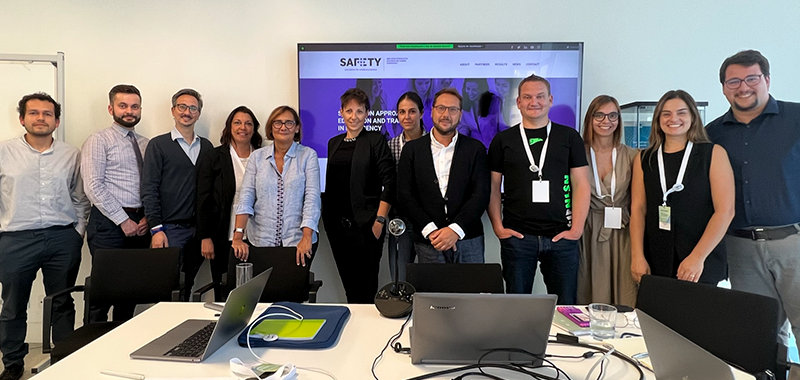
The SAFETY team just met for a two days physical meeting in Coimbra (Portugal) on 27-28th September.
After more than a year of online meetings, most partners took the chance to meet in person to discuss the project activities and define new steps for the next months to go (partners Laerdal and the University of Stavanger were connected online).
The company partner, Take the Wind – Body Interact, kindly hosted the event on their premises, introducing their core business and training services through a dedicated session with a practical demonstration using their virtual patient simulator, led by Pedro Pinto.
During the first part of the meeting, Prof. Gilda Cinnella (SAFETY Scientific Coordinator) and Dr Fedele Colantuono (SAFETY Project Manager) from the University of Foggia (Italy) discussed the latest achievements, focusing on the comments received by the European Commission evaluation on the first reporting period to improve implementation in the coming project tasks.
One of the main topics of the meeting was the discussion on the training material preparation for the online courses, addressed by Dr.s Katarina Grujic and Marc Lazarovici (Ludwig-Maximilians-Universität, Munich, Germany). They gave an overview of the theoretical and practical modules prepared by the different SAFETY academic partners and illustrated the last steps to have all materials validated until real preparation and simulation of the training course.
This discussion was enriched by the active presence of the SAFETY companies representatives, all simulation experts, respectively Rita Flores and Ana Santa (Take The Wind, Portugal), Lukas Dabruauer (Alpha Medical Concept, Austria) and Novella Callero (Laerdal, Italy), that explained the technical contribution they can provide in the training material preparation with their simulation tools, software and practical support.
Dr.s Cornelia Predoi and Mihai Stefan (Emergency Institute for cardiovascular diseases “Prof. Dr CC Iliescu”, Bucharest, Romania) introduced the action plan for the coming work package dedicated to turning training materials into e-learning courses. Since these activities will contribute to the main tangible results of the SAFETY, all partners discussed tasks implementation and deadlines to have achievements on due time, ready for dissemination and exploitation.
Given the importance of project communication, Dr Antonio Scrocco (InfoTech, Italy), as leader of the Dissemination and Communication, underlined the importance of this task for the project visibility and to exploit all main results that will be delivered to the different categories of stakeholders. He also mentioned the coming initiative of preparing short videos about simulation, project partners’ backgrounds, and project results to be spread on the SAFETY YouTube channel and other social media.
Moreover, Alessandro Guadagni (Valuedo, Italy) contributed during the meeting to moderate discussions, propose planning and wrap up all participants’ feedback and agreed procedures to complete the different work packages.
Before the meeting closure, academic partners focused on organizing different working groups to prepare scientific articles using the data and results obtained during the first period of SAFETY implementation. In particular, Dr Lucia Mirabella (UniFG), Dr Camilla Normand (University of Stavanger, Norway) and Dr Juan Perdomo (Hospital Clínic Barcelona, Spain) proposed the main topics to work on and a list of journals to be considered for publication.
This event represented an excellent opportunity for all partners to meet, discuss, and share experiences and suggestions to cooperate for the SAFETY project’s success. In less than six months, all partners decided to meet again and have another in-person meeting in Bucharest at the Emergency Institute for cardiovascular diseases “Prof. Dr CC Iliescu”, Romania.
Written by Dr Fedele Colantuono from the University of Foggia, Italy



